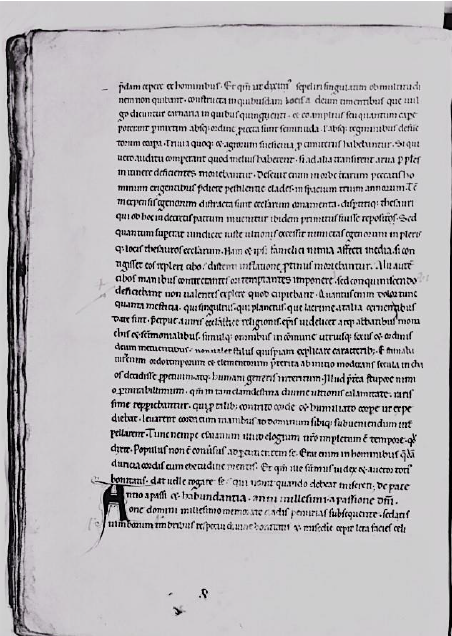Opinion 
 Creative Commons, CC-BY
Creative Commons, CC-BY
Refeeding Syndrome in Historical Perspective: Its First Description by Rodulfus Glaber (1033)
*Corresponding author: Dullaart RPF, Department of Internal Medicine, University of Groningen and University Medical Centre Groningen, Groningen the Netherlands (RPFD).
Received: December 22, 2020; Published: January 7, 2021
DOI: 10.34297/AJBSR.2021.11.001643
Abstract
The refeeding syndrome refers to a potentially fatal situation hallmarked by sudden death and cardiac decompensation that can occur when a malnourished person is refeeded. Electrolyte disturbances are currently considered to play a role in its pathophysiology. In the absence of laboratory measurements, clinical descriptions of the refeeding syndrome so far date back to the early post world war II period, including anecdotal evidence from victims of the nazi concentration camps. Here we want to draw attention to a medieval description that fulfils the clinical description of the refeeding syndrome by the French monk, Rodolfus Glaber. He writes about people suffering from the Burgundy famine (1033) that “even when they received food, they became distended and died immediately” (fourth book, chapter 4, 13). With this reference to medieval famine, we wish to pay tribute to those who suffered from the holocaust 75 years after their liberation.
Introduction
The refeeding syndrome refers to a potentially fatal condition that can occur when malnourished people receive enteral or parenteral refeeding [1,2]. Sudden death and cardiac decompensation make part of the syndrome [1]. Its first probable description in medical literature dates back to the early post world war II period when Burger et al. [3] described unexpected death during in-hospital recovery of famine victims after liberation of Western Holland by allied forces [3]. In this report, electrolyte disturbances, which are now considered to play a central role in the refeeding syndrome [1,2] were not yet mentioned [3]. The syndrome has also been anecdotally suggested to afflict subjects who were liberated from the nazi concentration camps. One of us (J-P.H.) took care of a Spanish patient who survived the horror. His story tells that he and other boys were offered food and chocolate by allied soldiers when they were freed. Several boys got instructions from their still living mothers to refrain from excessive food intake. Most of them could not resist to this advice. They all died. But the still living patient managed to follow his mother’s advice. He survived. Such instructions to avoid excessive food replenishment likely stem from orally transferred advice over many generations. Ancient descriptions of the refeeding syndrome may go back to Hippocrates and Flavius Josephus, a Roman historian. Remarkably, despite many famines over centuries there is yet no reference to clinical symptoms consistent with the refeeding syndrome from medieval European literature.
Here we draw attention to a description consistent with the refeeding syndrome by Rodulfus Glaber (ca. 980-1046), a French monk who witnessed the Burgundy famine in 1033 [4]. Severe lack of food consequent to repeatedly failed harvests over three subsequent years struck all classes of inhabitants. Hunger made them to consume flesh of deceased humans which was even sold ready cooked at the local market [4,5]. In the five books of the Histories (Historiarum Libri Quinque), Glaber writes about people suffering from the famine that “even when they received food, they became distended and died immediately” (fourth book, chapter 4, 13 [5]) (Figure 1, showing text from a 12th century copy in Latin and English translation). The distension described in this text may be ascribed to (beriberi-induced) heart failure, although it may also be primarily be due to hunger edema. Heart failure and sudden death upon refeeding is an appreciated feature of the refeeding syndrome [1,2]. Therefore, we consider the description by Rodulfus Glaber to fulfil the clinical criteria of what we currently capture as the refeeding syndrome.

Figure 1: Text from Rodulfi Glabri. Historiarum Libri Quinque. (900-1046). Liber quartus, caput 4, 13 [5]. Nam et ipsi famelici, nimia affecti inedia, si contigisset eos repleri cibo, distenti inflatione protinus moriebantur. Some of the destitute were also greatly affected by the famine that even when they received food, they became distended and died immediately (p.193). Source Gallica.bnf.fr Bibliothèque nationale de France. Département des manuscrits Latin 6190, 12th century copy of the original, 38v.
With this reference to medieval famine, we wish to pay tribute to those who suffered from the holocaust 75 years after their liberation.
Disclosures
The authors declare they have no conflict of interest.
References
- Kraft MD, Btaiche IF, Sacks GS (2005) Review of the refeeding syndrome. Nutr Clin Pract 20(6): 625-633.
- Mehanna HM, Moledina J, Travis J (2008) Refeeding syndrome: what it is, and how to prevent and treat it. BMJ 336(7659): 1495-1498.
- Burger GCE, Sandstead HR, Drummond J (1945) Starvation in Western Holland: Lancet. 246(6366): 282-283.
- Duby G, Mil L (1967) Archives no 30 Edition Gallimard/Julliard, Paris 10.
- Glabri R, Glaber HLQ (1989) The Five Books of the Histories. Edited and translated by John France, Neithard Bulst, Paul Reynolds. Clarendon Press.



 We use cookies to ensure you get the best experience on our website.
We use cookies to ensure you get the best experience on our website.